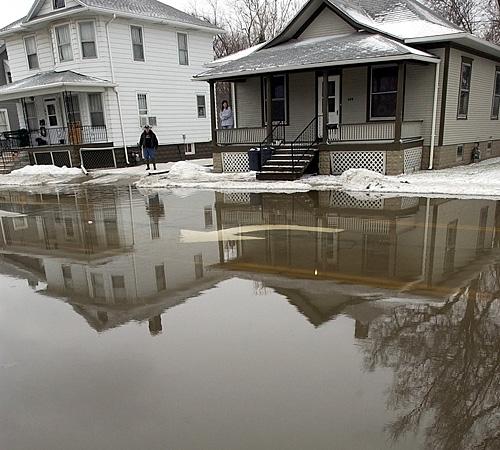Federal assistance request rejected

Homeowners along Route 24 watch as flood waters rise in Watseka, Ill., Thursday. Nicholas Holstein, The Associated Press
February 12, 2008
A request for federal assistance concerning severe January flooding in Livingston and Iroquois counties was denied by the Federal Emergency Management Agency (FEMA) on Wednesday.
Thunderstorms and rain hit the counties Jan. 7, causing a flood in both counties. The normal amount of rainfall for this region is usually about two inches in January, but some reports said there were four to six inches of rain during the storm, said Jim Angel, state climatologist.
“January is usually one of the driest months,” Angel said. “But there was almost spring-like weather that day.”
After a wet December, much of the soil was already very moist and unable to handle more rain, which was a main cause of the severe flooding, he said.
Within the city of Pontiac alone, more than 800 homes had some kind of water damage, and the city was one-third under water, said Steve McCoy, mayor of Pontiac. Several dozen residents are still out of their homes.
Get The Daily Illini in your inbox!
The amount of homes effected is still being calculated, according to the Illinois Emergency Management Agency (IEMA). Four hundred eighty two homes in the two counties were listed as impacted, 118 were originally determined to have major damage.
Pontiac, Watseka and many other towns were badly effected by the rain and the flooding that followed and are now working together to get federal assistance for the cleanup, McCoy said.
Both Iroquois and Livingston counties requested a federal disaster declaration on Jan. 18, but the request was denied Wednesday, said Cat Lengel, external affairs specialist for FEMA’s region 5.
“Based on a review of all of the information that was provided to us, it was determined that (the) situation was within the capabilities of the state to respond,” Lengel said.
Both FEMA and IEMA conducted preliminary damage assessments before the original request, Lengel said.
She added that some of the criteria reviewed for federal disaster declaration included the number of homes with damage and the amount of insurance coverage.
“We are very upset that we were denied (federal coverage),” McCoy said during a Monday press conference. “We feel the numbers reported are grossly under the actual number of damaged home and amount of severity.”
IEMA is now working with the towns affected to collect more data and resubmit an appeal, said Patti Thompson, communications manager for the agency.
“We thought that we had a good chance of getting the federal declaration because of the damage we saw,” Thompson said. “We are now working to see if there are more homes that could have been included in the original assessment.”
The municipalities will now be conducting their own assessments of flood damage by going door to door, leaving flyers and using local media to assess damage in the towns. They must submit their appeal to FEMA within 30 days of the request denial.
Officials for Pontiac have been working with Rep. Tim Johnson, R-Ill., on a daily basis and have also been in contact with Sen. Dick Durbin’s, D-Ill., office. McCoy said a call was also placed to Sen. Obama’s, D-Ill., office, but it has not yet been returned.
After the new assessments are submitted to FEMA, McCoy said they will wait again for a response.
“We are a little town in Middle America, and this is a silent disaster,” McCoy said. “Water goes up, and it goes back down, but there is a lot of damage left behind.”






